3 MIN READ
Should I replant my soybeans?
December 9, 2021
TRIAL OBJECTIVE
As midwestern farmers continue to plant soybeans progressively earlier than ever before, the risk of emerged seedlings encountering frost increases.
Largely due to the widespread adoption of treated soybean seed, growers now plant soybeans increasingly earlier than ever before; Illinois farmers had 41% of their soybean crop planted by May 2, 2021 compared to the previous 5-year average of 14%1
These early planting dates increase the risk of frost damage to emerged seedlings. The median date of the last 32°F freeze is April 25 in Woodford County2 where this research was conducted.
The goal of this research was to help growers make replant decisions when stands are reduced by frost or other factors.
Experiment/Trial Design
This research was conducted at the Bayer Crop Science FOCUS site in Woodford County in 2020 and 2021.
A 3.6 relative maturity (RM) soybean product was planted in 2020 and a 3.5 RM variety in 2021.
Plots were planted as early as soil conditions allowed in the spring. In 2020, a significant frost occurred on May 2, and in 2021 temperatures below 28°F occurred on consecutive days of April 20 and 21. The “replant” comparisons were planted as soon as soil conditions allowed after the frosts.
All seed was treated with Acceleron® Seed Applied Solutions STANDARD and ILeVO®.
Standard fertility and weed management practices were followed, and plots were harvested as they matured.
| Location | Roanoke, IL |
| Soil Type | Silt loam |
| Previous Crop |
Corn |
| Tillage Type |
Conventional |
| Planting Date | 3/7/20, 5/9/20 & 3/10/21, 5/3/21 |
| Harvest Date | 10/7/2020 & 10/18/2021 |
| Potential Yield (bu/acre) |
70 & 75 |
| Seeding Rate (seeds/acre) |
140,000 |
UNDERSTANDING THE RESULTS
Figure 1 highlights the importance of evaluating frost damage over a period of several days, as many severely damaged plants can survive and even thrive (Figure 1).
Over the two years included in the study, an average of 77,957 plants remained after frost, while an average of 124,775 remained in the replant comparison (Figure 2).
In both seasons, the surviving plants were fairly evenly distributed across the trial area.
Even with significantly reduced overall stand (which was a result of both delayed emergence and frost damage to the seedlings), the March plantings outperformed the replants by an average of 3.5 bushels/acre (Figure 2).
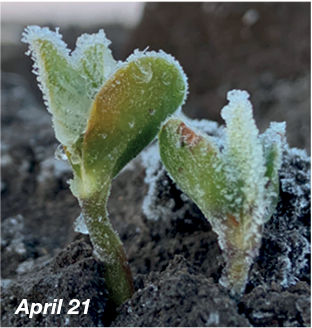
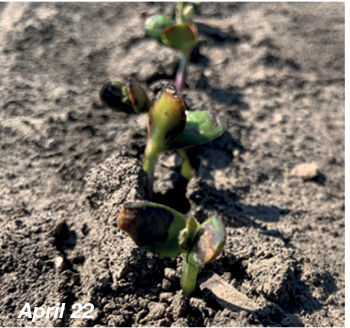
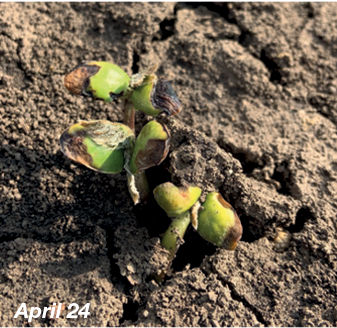
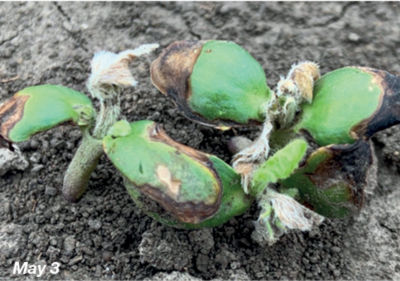
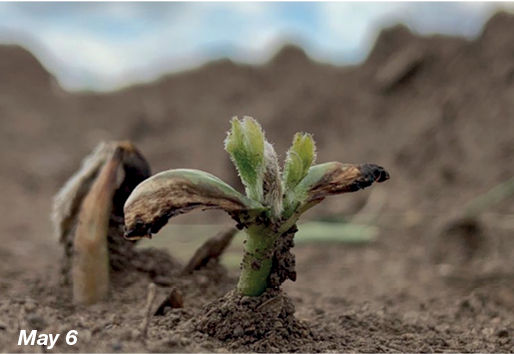
Figure 1. Damage and regrowth in soybean seedlings after heavy frost on morning of April 21, 2021
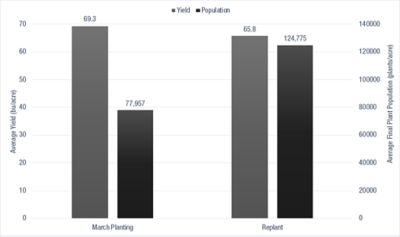
KEY LEARNINGS
When evaluating frost damage, it can take several days to determine the extent of the loss.3
In this study, due to soybeans ability to branch and produce additional podding sites with increased room to grow, the lower final population with an earlier planting date outperformed the higher population planted later.
Sources:
1USDA National Agricultural Statistic Service. https://www.nass.usda.gov/Statistics_by_State/Illinois/Publications/Crop_Progress_&_Condition/2021/20210503-IL-Crop-Progress.pdf
2Angel, J. Illinois frost dates and growing season. Illinois State Climatologist. https://www.isws.illinois.edu/statecli/frost/spring-freeze-32-median.png
3Potter, B., Bongard, P., Naeve, S., and Gunsolus, J. 2018. Spring Frost. University of Minnesota Extension. https://extension.umn.edu/growing-soybean/spring-frost
3011_R22